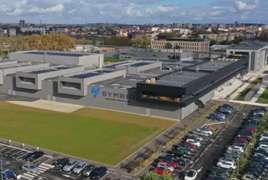 Symbio, an equally owned joint venture between Forvia, Michelin and Stellantis, has inaugurated SymphonHy, its first gigafactory. SymphonHy will enable Symbio to support its customers in making zero-emission hydrogen mobility an affordable reality, without compromising performance, it claims.
Symbio, an equally owned joint venture between Forvia, Michelin and Stellantis, has inaugurated SymphonHy, its first gigafactory. SymphonHy will enable Symbio to support its customers in making zero-emission hydrogen mobility an affordable reality, without compromising performance, it claims.
Located in Saint-Fons, in the Auvergne-Rhône-Alpes region, SymphonHy is the largest integrated fuel cell production site in Europe, confirming Symbio’s role as a technological and industrial leader. The site houses the group’s headquarters, a production plant, an innovation hub, and the Symbio Hydrogen Academy.
SymphonHy is touted to have a high level of automation and robotics supporting large-scale industrial production at a more competitive cost. These developments are key to accelerate the roll-out of competitive, high-performance hydrogen-powered transport, and contribute to the energy transition and the ambitions of Europe to move towards net zero.
SymphonHy in figures:
- A current production capacity of 16,000, to reach 50,000 by 2026
- An existing surface area of 26,000 sq m, 40,000 sq m by 2026
- 7,000 sq m of space dedicated to innovation
- 8,000 sq m of ISO 8-certified cleanrooms
· More than 450 engineers, including 100 dedicated to innovation and around 20 PhDs covering a wide range of disciplines (electrochemical engineering, chemistry, materials science, etc.), brought together in a single world-class innovation centre
With more than 30 years of experience, the support of its shareholders, leaders in the automotive world, and with 6 million km of road-testing already on the clock, Symbio has developed unique expertise. The group offers a broad portfolio of solutions that meet all power, durability and autonomy requirement for an efficient zero-emission mobility, from on-road light and mid-range commercial vehicles, trucks, pickups, buses and coaches, to off-road lifting and mechanical handling equipment.
With SymphonHy, Symbio is able to support its customers, pioneers of hydrogen-powered transport, in their deployment plans, which are already showing promise now, in real life.
Stellantis, one of the world’s leading automakers and also a Symbio co-shareholder, was the first company to market a zero-emission hydrogen solution for light commercial vehicles for the Peugeot e-Expert, Citroën e-Jumpy and Opel Vivaro-e models. The company is expanding its range to include large vans with a mid-power architecture, a range of up to 500 km and a recharge time of less than 10 minutes.
Stellantis confirmed its plans to develop a hydrogen technology for its Ram brand pickups, in line with its aim of electrifying its portfolio of vehicles with a range of 320 miles ALVW or 200 miles GCWR and fast tank refilling, without compromising on payload capacity. All these vehicles will be equipped with fuel cells produced by Symbio.
Moreover, in partnership with the German group Schaeffler, Symbio has set up a 50/50 joint-venture, Innoplate, to produce bipolar plates (BPPs), a strategic component in fuel cells. Based in Alsace, France, Innoplate will be operational in the first quarter of next year with an initial capacity of 4 million BPPs, rising to c. 50 million BPPs annually and employing over 120 people by 2030. Innoplate will help accelerate the production of new-generation BPPs for the PEM (proton exchange membrane) fuel cell market, improving performance and competitiveness while reducing costs.
Fuel cell technology complements battery technology for sustainable electric mobility. It is ideal for intensive and demanding professional usages entailing heavy loads, long distances, and quick refilling times. It is particularly well-suited to business transport.
SymphonHy is part of HyMotive, a strategic industrial and technological project supported by the European Union and the French government via the Important Projects of Common European Interest (IPCEI).
HyMotive represents a total multi-year investment of EUR1 billion. It plans to build a second gigafactory, doubling its overall production capacity in France to 100,000 systems a year by 2028. The project also aims to develop ground-breaking technology to support the competitiveness of fuel cell technology, with the aim of achieving parity with battery-powered electric mobility and traditional thermal technology by 2030.
From a workforce of 50 in 2019, Symbio now employs over 750 people and expects to create 1,000 jobs as a result of the HyMotive project.
Symbio has also been based in the US since 2021, already benefiting from a pilot plant in California that is sourced from the Group’s European facilities during a first phase.
Currently, Symbio is already looking for opportunities to expand and build a new fuel cell gigafactory in the US, to support the promising hydrogen mobility dynamics in North America.
SymphonHy is helping to define fuel cell production standards that will serve as the industrial model for its new sites, in line with Symbio’s aim to produce 200,000 units worldwide by 2030.
